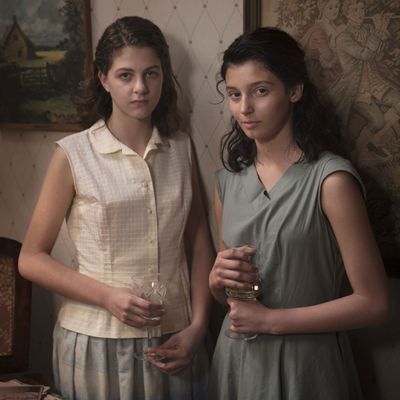
Italy is a 19th-century invention unified by an official language that, until the 20th century, most Italians didn’t speak. Elena Ferrante’s My Brilliant Friend, the first of the four volumes of her Neopolitan Novels, takes place on the outskirts of Naples, in a neighborhood isolated by dialect as well as by poverty. Ferrante avoids transcribing the speech patterns of the street, writing out everything in proper Italian and inserting a clause to specify whether the speaker is using Neapolitan dialect or not. This saves the reader from having to struggle through laboriously rendered, potentially offensive slang à la Huckleberry Finn, and it also makes it impossible to forget how far the narrator, Elena Greco, has traveled, from her days as a postwar urchin to the heights of literary respectability.
In the HBO adaptation of My Brilliant Friend, director Saverio Costanzo addresses the problem in a completely different fashion: by casting local kids, filming in Neapolitan, and providing Italian subtitles that viewers can fool themselves into thinking they could really do without. Elena’s trajectory is the story of a woman changing her speech, and with it the trammels of class, family, brutality, and loyalty. Costanzo sets the parameters in the opening scene, set in the present, when an iPhone buzzes on Elena’s bedside table. Sleepy and startled, she answers in educated Italian, with a hyper-proper “Pronto?” At the other end of the line is a young voice from her old life; the son of her childhood friend informs her in thick Neapolitan that Lila has disappeared: “Mammà ‘nzè tròve cchiù.” She understands, but her peers wouldn’t, not without subtitles.
There is a difference between Italian spoken with a Naples accent — a cadence rich in diphthongs, gaping vowels, and mushy sh sounds — and actual Neapolitan, which is impenetrable to an outsider from, say, even a few dozen miles away. Every Italian knows a few, mockable phrases: guagliò for “dude,” vabbuò instead of va bene (“all right”) or boh, che ne saccio in place of non lo so (“I don’t know”). Movies and television, which have to balance regional authenticity and mass appeal, have created a kind of Italo-neapolitan hybrid, colorful but comprehensible. In the 1980s, the comedian Massimo Troisi helped make his native dialect safe for national consumption, but he was careful to stay within the lines of intelligibility. The dialect continues to be a source of merriment and pride: Last month, when the Naples-born TV personality Stefano De Martino taught his son a few useful phrases, the 30-second final exam became a viral sensation.
Costanzo, though, is after something much more textured and profound than authenticity or local color: He uses gradations of dialect to delineate class, reveal the characters’ psychology, and propel the plot. After that middle-of-the-night phone call, the story winds back to the 1950s, when the only neighborhood presences who speak true Italian are teachers and librarians. But among the proletariat, too, even the toughest forms of dialect bend to circumstance. In the first episode, a poor carpenter confronts Stefano Carracci, the son of the gangster who evicted him, and the scene plays out in tight, bitter Neapolitan:
By episode four, Stefano, now an affluent young shopkeeper, invites the neighbors over for New Year’s Eve and offers a toast in Italian that belies the meagerness of his education. He is conciliatory, generous, and brimming with ambition. He is the new Italian man.
The degree of dialect denotes more than social class; it also hints at the speaker’s loyalties. A local crime boss swears by family and speaks the local lingo. An aspiring scholar speaks Italian, has thoughts on national politics, and can’t wait to escape the grasping, provincial South. After World War II, Italy had to form itself anew, stitching together disparate cultures into a rickety idea of nationhood. Compulsory military service helped. So did television and the schools. But it was the burgeoning economy that did the most to tie together the fortunes of citizens who might otherwise have had nothing to do with each other. Stefano Carracci understands that there’s money to be made and customers to be wooed beyond the few blocks he calls home, and he is ready to speak their language. Still, the Italian project took time and in the 1950s, it was still far from complete.
Many Italian viewers of My Brilliant Friend will recognize the interplay of nationhood and language from a scene in Giuseppe Tomasi di Lampedusa’s classic novel The Leopard, set in Sicily in 1860 but written in the 1950s, just when the teenage Elena is struggling with her Latin declensions. In The Leopard, an aging prince who is contemplating the birth of modern Italy pays a visit to the Bourbon king in Naples. Though the nobleman addresses his sovereign in immaculate Italian, Francis II greets him in chewy Neapolitan. The moment is both comic and pointed: The monarch comes from a Spanish dynasty and rules a major chunk of the Mediterranean, but he’s no global figure, or even a national one. He’s a local kid, as provincial in his worldview as the fruit-seller outside his palace.
In Ferrante’s world, a similar set of tensions — between the block and the nation, between family and education, the gun and the mind — play out in the subtleties of speech. When Lila’s parents decide to yank the girl out of school and put her to work, her older brother Rino (already a dropout) defends her right to an education — in blistering, inimitable dialect. The irony is deliberate: He uses Neapolitan to try to push her out of the family’s Neapolitan-speaking orbit.
Even as a young girl, Elena learns to code switch. She slips in and out of the neighborhood’s argot, especially when she’s talking to Lila. As long as the topic is confined to parents, boys, or menstruation, Neapolitan is the language of choice. But when they compare notes on books, they slip into Italian. Costanzo has a careful ear, and he doesn’t miss a chance to make it clear that, for the older Elena, the one who answers the phone in the middle of the night and whose memories give this epic its structure and frame, Neapolitan is the language of the imprisoning neighborhood; Italian is the language of ideas, the imagination, and social mobility — in a word, the language of freedom.
There is a deeper, unstated irony here. The show, co-produced by an American company for a global audience, is being released into an Italy that seems to have forgotten its past. Today, a right-wing, immigrant-phobic, anti-EU government with Putinesque sympathies is pulling the nation away from a polyglot Europe and asserting an Italy First agenda. As the country turns inward again, it has little to show for decades of foreign language instruction. Italians theoretically study English in school, but their command of the language is among the worst in Europe. (Americans have nothing to feel superior about on that front, however: We barely even bother to master a foreign language in school.)
That’s tragic. English is to Italians today what Italian was to Neapolitans in the 1950s: the key to a more cosmopolitan future. And yet many of those who speak it best flee to find their futures abroad, leaving their monolingual homeland ever more insular. Language preservationists, and even UNESCO, rush to the rescue of fading dialects; fluency in Neapolitan remains a badge of honor. That’s wonderful, and it’s what made it possible to shoot My Brilliant Friend in the first place. But the older Elena who answers her phone in the opening scene lives in a different country, one that should be looking beyond its borders. Instead, it’s barricading itself ever more firmly into a large-scale version of Ferrante’s fictional neighborhood and doubling down on a language that few people beyond its borders speak or understand. Early on in My Brilliant Friend, Elena and Lila cement their friendship by raptly reading to each other from a translation of Little Women. Today, Italian children craving a world beyond the confines of their lives really ought to be reading such a book aloud to each other in the original.


